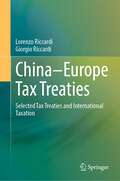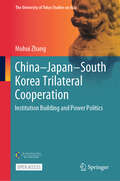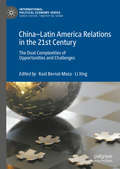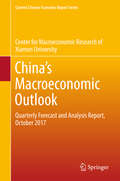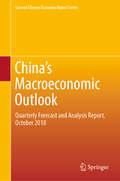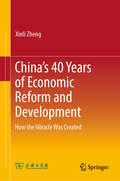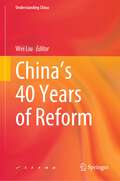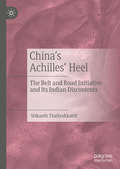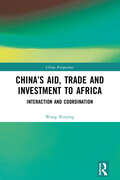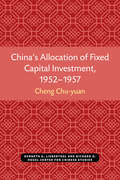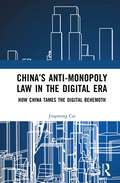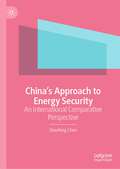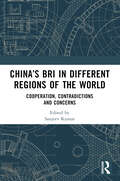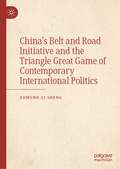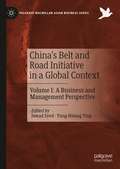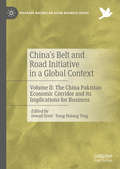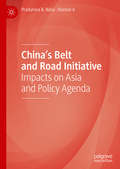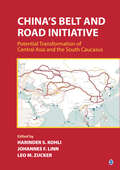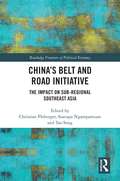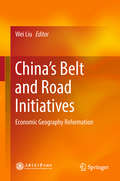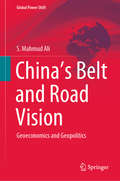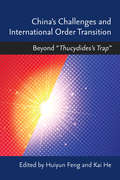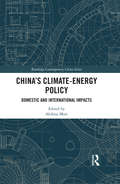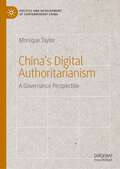- Table View
- List View
China–Europe Tax Treaties: Selected Tax Treaties and International Taxation
by Lorenzo Riccardi Giorgio RiccardiThis book covers the Tax Treaties which The People’s Republic of China has signed with various nations of the European Region. This book is a collection of the treaties, supplementary materials, and selected implementing circulars. It is edited and ordered according to geographical/economic criteria and accompanied with integrated with tables, domestic tax systems reports, and accompanying circulars and treaty model texts. This book has never been compiled for Chinese tax treaties before, providing a new resource for firms and researchers to access the materials with ease. This book has the potential to be a part of a volume on China double tax treaties, and the book will encompass the entirety of China’s Global Tax treaties. The intended readership of this book will be primarily professionals who are working in both the international accounting and legal industries. These readers frequently reference the treaties through the course of their normal business for the purpose of forming optimum tax structures and corporate structuring. However, it is also foreseeable that this book will be of interest to academic researchers in multiple fields from geo-politics, accounting, legal to economics.
China–Japan–South Korea Trilateral Cooperation: Institution Building and Power Politics (The University of Tokyo Studies on Asia)
by Muhui ZhangThis open access book aims to review the history, achievements, and challenges of trilateral cooperation among China, Japan, and South Korea in a systematic way. It offers numerous perspectives to explain the emergence of trilateral institution-building processes and the fluctuations of trilateral cooperation, and underscores three countries’ respective policy stances towards the building of the triangle. The evolvement of political and economic ties among China, Japan, and South Korea has vital importance to the peace and prosperity of East Asia. Recent years have witnessed the ups and downs of the trilateral cooperation among the three countries. The development of trilateral institution building emerged as a joint gesture in response to the Asian Financial Crisis in the late 1990s. The three countries jointly established multilayered cooperative mechanisms in a wide range of fields. Nonetheless, trilateral cooperation among the three major powers has been proceeding in hardship in the shadow of longstanding geopolitical complexity and the deepening Sino-US confrontations. This book argues that, despite growing economic and social linkages, political animosities have constantly impeded the trilateral cooperation. Relevant to scholars and advanced students in international relations and political economy, this is a vital read in East Asian studies.
China–Latin America Relations in the 21st Century: The Dual Complexities of Opportunities and Challenges (International Political Economy Series)
by Li Xing Raúl Bernal-MezaThis book conceptualizes the economic relations between China and Latin America in different national cases from the perspectives of international political economy–based structuralism theory, the core-periphery model and the world system theory. It contributes to the interpretation of the consequences of the interaction between China’s successful modernization and Latin America’s failed development model.
China‘s Macroeconomic Outlook: Quarterly Forecast And Analysis Report, February 2017 (Current Chinese Economic Report Ser.)
by Xiamen University Center for Macroeconomic Research ofThis report is a partial result of the China’s Quarterly Macroeconometric Model (CQMM), a project developed and maintained by the Center for Macroeconomic Research (CMR) at Xiamen University. The CMR is one of the Key Research Institutes of Humanities and Social Sciences sponsored by the Ministry of Education of China, focusing on China’s economic forecast and macroeconomic policy analysis. The CMR started to develop the CQMM for purpose of short-term forecasting, policy analysis, and simulation in 2005.Based on the CQMM, the CMR and its partners hold press conferences to release forecasts for China’ major macroeconomic variables. Since July, 2006, twenty-two quarterly reports on China’s macroeconomic outlook have been presented and eleventh annual reports have been published. This 23rd quarterly report is to be presented at the Forum on China’s Macroeconomic Outlook and Press Conference of CQMM on October 27, 2017. This conference is jointly held at Oxford University by Oxford Prospects and Global Development Centre, University of Oxford, Center for Macroeconomic Research at Xiamen University, and Economic Information Daily at Xinhua News Agency.
China‘s Macroeconomic Outlook: Quarterly Forecast and Analysis Report, October 2018 (Current Chinese Economic Report Series)
by Center for Macroeconomic ResearchThis report is a partial result of the China’s Quarterly Macroeconometric Model (CQMM), a project developed and maintained by the Center for Macroeconomic Research (CMR) at Xiamen University. The CMR is one of the Key Research Institutes of Humanities and Social Sciences sponsored by the Ministry of Education of China, focusing on China’s economic growth and macroeconomic policy. The CMR started to develop the CQMM for purpose of short-term forecasting, policy analysis, and simulation in 2005.Based on the CQMM, the CMR and its partners hold press conferences to release forecasts for China’ major macroeconomic variables. Since July 2006, twenty-four quarterly reports on China’s macroeconomic outlook have been presented and eleven annual reports have been published.This 25th quarterly report was presented at the Forum on China’s Macroeconomic Outlook and Press Conference of CQMM on October 25, 2018. This conference was jointly held by SOAS London University, Xiamen University, and Economic Information Daily in London, UK.
China’s 40 Years of Economic Reform and Development: How the Miracle Was Created
by Xinli ZhengThis book aims to explain the secret to China’s rapid growth over the last 40 years from the viewpoint of a firsthand witness. Zheng Xinli was enrolled as a graduate student of economics 40 years ago, at a time when very few Chinese people could enroll in higher-level education, let alone graduate school. Since 1978, he has been engaged in the study of macroeconomic theory and economic policy. He has worked with the economic group of the Research Section of the Secretariat of the Central Committee of the Communist Party of China, the State Information Center, and the Policy Research Office of the State Planning Commission, as well as other organizations. His work serves to help Chinese leaders in making economic decisions. In 2013, Zheng Xinli appeared on the list of China’s Top Ten Economists. With the addition of several up-to-date articles, this book is mainly a condensed version of a 16-volume collection of essays selected from among the more-than-500 articles published by Zheng between 1981 and 2016. Addressing some of the major issues in China, namely, Reform and Development, Development Patterns, Macro Regulation, Balanced Urban and Rural Development, Innovation, and Industry Revitalization, the book, as Zheng himself puts it, visualizes the birth process of different policies and measures which have catered to the different stages of reform. As an insider, and also partly as a designer and architect, Zheng Xinli provides readers with a view of China’s reform from the top.
China’s 40 Years of Reform (Understanding China)
by Wei LiuThis book focuses on the key issues around Chinese reform in the past 40 years, including economic structure upgrading, finance reform, enterprise ecology, village modernization, ecological development, income structure, global governance, BRI, and governance model. It collects the most important concerns and reveals the deep logic behind the reform. By reading this book, it helps readers to grasp the engine of China’s continuous growth toward modernization in the four decades.
China’s Achilles’ Heel: The Belt and Road Initiative and Its Indian Discontents
by Srikanth ThaliyakkattilThis book analyses Chinese discourse on Indian attitudes towards the Belt & Road Initiative (BRI), and argues that the Indian discourse is becoming one of the biggest hurdles to China creating its own narrative about China’s rise in Asia and beyond. In doing so, it spans across the themes of the power struggle between China and US, China and India, the Chinese perception of India, China-South Asia relations, the China-US- India strategic triangle and the success and failures of BRI. The first part of the book focuses on the Chinese thinking behind the launch of the BRI and addresses questions related to the purpose of this initiative and ways in which it will facilitate China’s rise as a superpower. Subsequently the book addresses how effective or ineffective India’s challenge is and how it is negatively affecting China’s BRI.
China’s Aid, Trade and Investment to Africa: Interaction and Coordination (China Perspectives)
by Wang XinyingAdopting perspectives from development economics and international relations, this book researches the ongoing cooperation between China and African countries and the interactive system of China’s aid, trade and investment to and with Africa. In reviewing the history and development of China-Africa relations from the founding of the People’s Republic to the new century, the book analyses the achievements, opportunities and challenges of the bilateral relationship and reflects on the public-private partnership model in the context of international development assistance. Coupled with experiences from the US, Japan and the EU in the field of foreign aid, trade and investment as well as case studies from China, the core chapters delve into China-Africa cooperation in terms of aid, trade and investment and proposes to build an interactive and coordinated mechanism of China’s aid, trade and investment in Africa. The author argues that China-Africa cooperation goes beyond reciprocal benefits, offering a possible model for South-South Cooperation and a potential model for balanced and sustainable development within the world economy. This book will appeal to researchers, students and policy makers interested in Chinese politics and foreign policy, African politics, international relations, international diplomacy and the world economy.
China’s Allocation of Fixed Capital Investment, 1952–1957 (Michigan Monographs In Chinese Studies #17)
by Chu-yuan ChengChina’s efforts to stimulate industrial development and economic growth through the allocation of investments are analyzed. Cheng concludes with an overall assessment of the distinctive features of the allocation pattern. Includes 41 statistical tables.
China’s Anti-monopoly Law in the Digital Era: How China Tames the Digital Behemoth
by Jingmeng CaiThe book aims to depict the whole picture of China's Anti-Monopoly Law (AML) in the digital sector and reveals the three key factors that shape AML enforcement.The author introduces the legal revolution and a major enforcement campaign in the digital sector. She focuses on three typical monopolistic behaviours—abuse of dominant position, merger control, and monopoly agreements. High-profile cases—such as administrative penalties against Alibaba and Tencent and private lawsuits against Apple and Didi Chuxing—are discussed in detail. She also identifies three underlying factors that have influenced AML enforcement reform: the political factor, the legal factor, and the academic factor. Finally, the book raises open questions and challenges that are relevant not only to China but to a wide range of jurisdictions.The book will appeal to competition law (antitrust) and Chinese law academics, practitioners, and officials, as well as general readers interested in the subject.
China’s Approach to Energy Security: An International Comparative Perspective
by Shaofeng ChenThis book aims to analyze how and why China takes a state-managed marketization approach (SMMA) to energy security against the backdrop of global efforts of decarbonization and intensified strategic competition between China and the United States. How, and why, does China's SMMA work? Taking an evolving, historical perspective, this book explores China’s perception of energy security, the policy process, institutional restructuring in China's petroleum industry, China's foreign energy quest, and the ramifications of the Chinese approach on the international energy market and on world decarbonization. To demonstrate to what extent China’s SMMA differs from other countries, it also makes a comparative analyses of the approaches by China, the US and India. This book will keenly interest scholars of the Chinese political economy, climate change, and geopolitics.
China’s BRI in Different Regions of the World: Cooperation, Contradictions and Concerns
by Sanjeev KumarChina’s Belt and Road Initiative (BRI) is completing a decade. There have been varied responses to the Initiative from countries and regions besides the emergence of alternative initiatives and narratives. This sets the stage for evaluating the robustness of the Initiative, its implementation as well as its implications from the perspective of individual countries and regions across the globe. This book begins by examining China’s domestic, economic, maritime and strategic interests as drivers for the Initiative. BRI has been analysed in country-specific, regional and continental contexts. It brings out the experiences and responses from South Asia, Eurasia, East Asia, Southeast Asia, the Arab world, Latin America, the Caribbean as well as from Europe and Africa. Further, BRI has been studied in the larger context of the US-China competition. The final section explores BRI in the context of the twin challenges of recent times, i.e., the pandemic and Russia-Ukraine conflict. The book concludes with an epilogue which outlines the broad trends related to BRI that have emerged from this study of ICWA.
China’s Belt and Road Initiative and the Triangle Great Game of Contemporary International Politics
by Edmund Li ShengThis book focuses on the triangular relations between China, the United States and the European Union from the perspective of the Belt and Road Initiative (BRI) via the methodology of international political economy. China, the US and the EU are the three most important players in international politics and the global economy, and their relations are accordingly among the most influential in the global arena. This book will argue that the interactions between China, the US and the EU are highly dynamic given their close connections in trade, finance and many other economic fields. In the context of US–China competition, the decisions of the EU, which has sought to remain independent in its foreign policy for decades, crucially shape the landscape of international politics, and lucidly articulates how international relations look from China to scholars of geopolitics.
China’s Belt and Road Initiative in a Global Context: Volume I: A Business and Management Perspective (Palgrave Macmillan Asian Business Series)
by Jawad Syed Yung-Hsiang YingBringing together a collection of interdisciplinary chapters on China’s Belt and Road Initiative (BRI, or also known as One Belt One Road), this book offers a comprehensive overview of the topic from a business and management perspective. With contributions from scholars based in Asia, Europe and North America, Volume I provides theoretical and empirical analysis of the opportunities and challenges facing businesses in relation to BRI. Key areas covered include economics and finance, history, trade, value chain and human resource and cross-cultural management, creating a useful tool for academics, as well as policy-makers and practitioners in China and other countries along the new Silk Road.
China’s Belt and Road Initiative in a Global Context: Volume II: The China Pakistan Economic Corridor and its Implications for Business (Palgrave Macmillan Asian Business Series)
by Jawad Syed Yung-Hsiang YingBringing together a collection of interdisciplinary chapters on China’s Belt and Road Initiative (BRI), this book offers a comprehensive overview of the topic from a business and management perspective. With a focus on the China Pakistan Economic Corridor (CPEC), Volume II provides theoretical and empirical analyses of the opportunities and challenges facing businesses. With contributions covering economics, agriculture, energy, value chain, ethics, governance, and security, this collection is a useful tool for academics as well as policy-makers and practitioners in China, Pakistan, and other countries along the new Silk Road.
China’s Belt and Road Initiative: Impacts on Asia and Policy Agenda
by Pradumna B. Rana Xianbai JiThe Belt and Road Initiative (BRI), officially unveiled in 2013, is Chinese President Xi Jinping’s signature foreign and economic policy initiative to achieve improved connectivity, regional cooperation, and economic development on a trans-continental scale. This book reviews the evolving BRI vision and offers a benefit-risk assessment of the BRI’s economic and geopolitical implications from the perspective of Asian stakeholder countries, using both qualitative and quantitative research methods. Among the value added of the book is first an online perception survey of opinion leaders from Asian participating countries on various aspects of the initiative. To our best knowledge, the survey is the first of its kind. Second, the book presents the simulation results of a computable general equilibrium model of the world economy to estimate the potential macroeconomic impacts of the BRI as a whole and those of its constituent overland and maritime economic corridors. Third, the book makes ten key evidence-based policy recommendations on how to enhance the prospect of a successful and mutually beneficial BRI 2.0 to both China and stakeholder countries.
China’s Belt and Road Initiative: Potential Transformation of Central Asia and the South Caucasus
by Harinder S. Kohli, Johannes F. Linn and Leo M. ZuckerChina’s Belt and Road Initiative (BRI) is a potential gamechanger for the Central Asia and South Caucasus (CASC) region. CASC countries naturally view this massive development program as a unique opportunity to accelerate their economic development through increased foreign investment, upgraded physical infrastructure, and tighter economic relationships with their neighbors. Yet embracing the BRI is not without risks. Some BRI investments may prove to be fiscally unsustainable, economically and financially unviable, and socially and environmentally harmful. Inadequate cross-border coordination and infrastructure maintenance could render some BRI investments wasteful or redundant. If not proactively addressed, these risks have the potential to leave countries worse off for having participated in the BRI. Policymakers in the CASC region and their development partners, thus, face a daunting question: how to realize the promise of the BRI for their countries while avoiding the pitfalls that lie along the way? This book attempts to answer this question by leveraging the unique insights of development experts in the CASC region. Drawing on the most comprehensive review of BRI investment data conducted to date, this book presents a dynamic policy agenda that is relevant to any country in which China is building the Belt and Road.
China’s Belt and Road Initiative: The Impact on Sub-regional Southeast Asia (Routledge Frontiers of Political Economy)
by Tao Song Christian Ploberger Soavapa NgampamuanThis book evaluates China’s relations with sub-regional Southeast Asia through its Belt and Road Initiative (BRI) and the Lancang-Mekong Cooperation framework. The book looks at domestic drivers and regional receptivity of China’s Belt and Road Initiative and also delves into the challenges of China’s engagement in the Greater Mekong Sub-region. The book examines how China’s BRI will contribute to the development of these countries, to regional economic integration and cooperation processes within a political-economic context. It addresses the BRI process within the GMS on three levels: regional, individual recipient countries and the Chinese perspective. The case studies in the book will help to provide insights on China’s growing economic influence in sub-regional Southeast Asia and its Belt and Road Initiative. This book will appeal to researchers interested in the BRI, China's relations with Southeast Asia and China’s neighbourhood policy and how domestic considerations are influencing China’s policy making.
China’s Belt and Road Initiatives: Economic Geography Reformation
by Wei LiuThis book presents the series of lectures on the "Belt and Road Initiatives" from the Guang Ming Forum organized by Guang Ming Daily. Co-authored by Ge Jianxiong, Hu Angang, Lin Yifu, Qiao Liang and nine other respected scholars and experts, it provides a comprehensive analysis of the "Belt and Road Initiatives" and its significance in terms of economics and economic geography, yielding an insightful interpretation of the strategy. It also offers multiple perspectives, including national political, historical, military, diplomatic, cultural, technological and legal.
China’s Belt and Road Vision: Geoeconomics and Geopolitics (Global Power Shift)
by S. Mahmud AliThis book examines the evolution and major elements of China’s Belt-and-Road Initiative (BRI), a trillion-dollar project for the revival and refinement of ancient terrestrial and maritime trade routes. The author analyses the foreign policy and economic strategy behind the initiative as well as the geoeconomic and geopolitical impact on the region. Furthermore, he assesses whether the BRI has to be considered as a challenge to the US-led order, leading to a Sinocentric order in the 21st century. Offering two case studies on the China-Pakistan Economic Corridor (CPEC) and the 21st Century Maritime Silk Road (MSR), the book reveals the drivers motivating China and its partners in executing BRI projects, such as security of commodity-shipments, energy supplies, and explores trade volumes as well as the anxiety these trigger among critics. The book juxtaposes these to non-Chinese, specifically multilateral institutional and Western corporate, inputs into Beijing’s developmental planning-processes. It also identifies the role of combined Chinese-foreign stimuli in generating the policy priorities precipitating the BRI vision, and the geoeconomic essence of BRI’s implementation.
China’s Challenges and International Order Transition: Beyond “Thucydides's Trap”
by Kai He Huiyun FengChina’s Challenges and International Order Transition introduces an integrated conceptual framework of “international order” categorized by three levels (power, rules, and norms) and three issue-areas (security, political, and economic). Each contributor engages one or more of these analytical dimensions to examine two questions: (1) Has China already challenged this dimension of international order? (2) How will China challenge this dimension of international order in the future? The contested views and perspectives in this volume suggest it is too simple to assume an inevitable conflict between China and the outside world. With different strategies to challenge or reform the many dimensions of international order, China’s role is not a one-way street. It is an interactive process in which the world may change China as much as China may change the world. The aim of the book is to broaden the debate beyond the “Thucydides Trap” perspective currently popular in the West. Rather than offering a single argument, this volume offers a platform for scholars, especially Chinese scholars vs. Western scholars, to exchange and debate their different views and perspectives on China and the potential transition of international order.
China’s Climate-Energy Policy: Domestic and International Impacts (Routledge Contemporary China Series)
by Akihisa MoriChina’s recent climate-energy policy, an outcome of contemporary challenges, has generated conflict of interest amongst major stakeholders. Coupled with a boost in demand for oil, gas and coal, as well as a rapid growth in wind and solar power, it has not only affected domestic fossil fuel and renewable energy providers, but has also provoked a resource boom, affecting development pathways internationally. This book therefore seeks to examine the economic, social and ecological effects associated with China’s climate-energy policy. Assessing how the policy has been and will be formulated and implemented, it analyses the changing use of energy, CO2 emissions and GDP, as well as social and environmental impacts both domestically and internationally. It presents in-depth case studies on specific policies in China and on its resource exporting countries, such as Indonesia, Australia, Myanmar and Mongolia. At the same time, using quantitative data, it provides detailed input-output and applied computable general equilibrium analyses. Arguing that China has actively advanced its climate-energy policy to become a leader of global climate governance, it demonstrates that China ultimately relocates the cost of its climate-energy policy to resource exporting countries. This book will be of great interest to students and scholars of energy, the environment and sustainability, as well as Chinese Studies and economics.
China’s Crony Capitalism
by Minxin PeiChina's efforts to modernize yielded a kleptocracy characterized by corruption, wealth inequality, and social tensions. Rejecting conventional platitudes about the resilience of Party rule, Minxin Pei gathers unambiguous evidence that beneath China's facade of ever-expanding prosperity and power lies a Leninist state in an advanced stage of decay.
China’s Digital Authoritarianism: A Governance Perspective (Politics and Development of Contemporary China)
by Monique TaylorThis book provides a governance perspective on China’s digital authoritarianism by examining the political and institutional dynamics of the country’s internet sector in a historical context. Using leading theories of authoritarian institutions, it discusses China’s approach to the internet and methods of implementation in terms of party-state institutions and policy processes. This provides a much-needed ‘inside out’ perspective on digital authoritarianism that avoids the perception of China as some coherent and static monolith. The study also offers a powerful rationale for China’s cyber sovereignty as an externalisation of its domestic internet governance framework and broader political-economic context. As China shifts from rule-taker to rule-maker in world politics, the Chinese Dream (zhongguo meng) is now going global. Beijing’s digital authoritarian toolkit is being promoted and exported to other authoritarian regimes, making China a major driver of digital repression at the global level.
